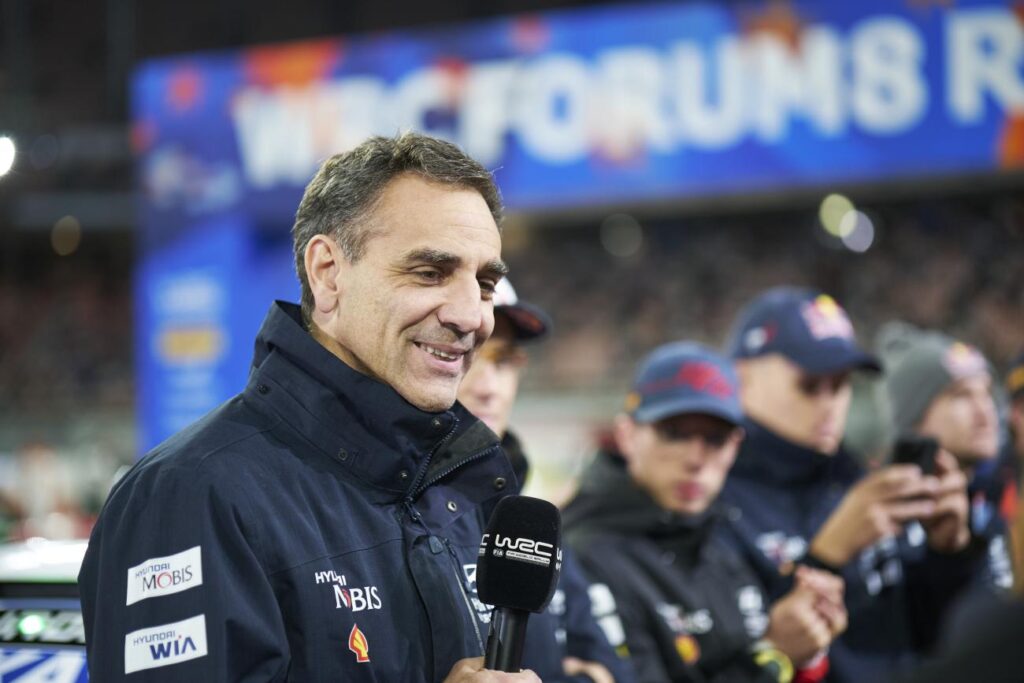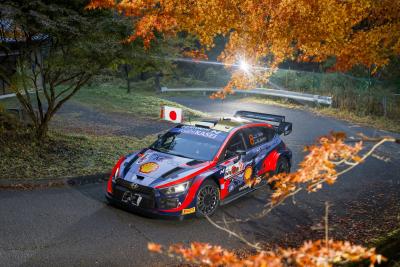It’s the first day of Rally Japan, the season-ending round of 2024’s World Rally Championship, and Hyundai team boss Cyril Abiteboul should be in a good mood. One of his drivers – either Estonia’s Ott Tänak or Belgium’s Thierry Neuville – is guaranteed to win this year’s Drivers’ Championship; and Hyundai, along with Toyota, still has a good shot at the Manufacturers’ title too.
Of course, it’s the first day of a four-day event, so even with guaranteed glory in one championship, the celebrations can’t begin yet. Abiteboul – the 47-year-old Frenchman who became an unexpected household name as the head of the Renault F1 team in the early days of Drive to Survive – is still in full-on work mode.
Amid the bustle, though, he’s happy to discuss the state of the WRC in 2024 – and on the surface, things don’t look great. Since Citroen pulled out as a works team at the end of 2019, the sport’s top class – Rally1 – has been populated by just three teams: Hyundai, Toyota, and a Ford effort run wholesale by the independent M-Sport outfit.
The fact is that rallying simply isn’t the massive global phenomenon it has been in the past. Blame it on whatever you like: lack of manufacturer interest, poor coverage, or, at the risk of sounding like an old fart, a format fundamentally at odds with what the TikTok generation wants and expects.
It may be easier to win a championship with only two competitors (something Hyundai ultimately wouldn’t do, narrowly losing out to Toyota after the two manufacturers went into the final stage completely inseparable on points), but Abiteboul is frank that the sport’s health hinges around bringing in new manufacturers. How would he do that?
“I don’t think there’s one silver bullet,” says Abiteboul. “It’s probably a combination of elements, and the main one is cost. The sport is way too expensive, particularly if you want to operate at a high level.”
That’s a fairly obvious answer, and the proof is in other motorsport formats. The new generation of Hypercars racing in the World Endurance Championship may be a full 10 seconds a lap slower around Le Mans than their LMP1, but just look at the influx of competitors the cheaper, simpler format has brought – Hyundai among them, through its Genesis sub-brand.
It’s not as simple as merely slashing costs, though, reckons Abiteboul. “The cost is the cost, and then there’s the value. The value is very much connected to the mission and the vision of the sport, and I think it’s a sport that’s missing a purpose.
“Historically, rally has used production cars, as least as silhouettes… it’s very challenging to find the right car, the right powertrain for rally. If you ask me, you need to reduce the cost, define a clear vision and a clear purpose, and you need to make sure to have the right car to equip the sport.”
It’s a fair point – B-segment superminis have (largely) served as the basis of top-flight rally cars since 2011. In the new car market, though, these cars’ sales are dwindling as people flock relentlessly to crossovers. Of the three current Rally1 squads, it’s only M-Sport that’s adapted, moving from Ford Fiesta to Puma a few years ago.
Would a regulatory push towards the sort of cars the masses actually buy help attract more manufacturers? Perhaps, but two of the best attainable performance cars of recent years, the Hyundai i20 N and Toyota GR Yaris, have had close links to their manufacturers’ rally programmes. They probably wouldn’t have existed if Toyota and Hyundai were running the C-HR and the Kona in the WRC instead, and that would be bad news for enthusiasts.
Powertrains raise an obvious question, too. For 2022, the WRC moved to hybrid power. Now, after lots of on-again, off-again discussion, it’s been confirmed that for 2025, hybrids will be dropped after just three years – good for cost, seemingly bad for relevancy to road cars.
The FIA, for its part, has acknowledged all this, penning new regulations due to come into effect in 2027. These are designed to tackle cost, slashing the development cost cap to €345,000 (around £285,000); and base car choice, with a control spaceframe chassis from which manufacturers can hang bodywork resembling pretty much any car they want, or even do a bespoke rally prototype.
Those regs are also intended to be capable of housing combustion, hybrid or full EV powertrains, although initially, the focus will be on sustainably-fuelled combustion engines. Abiteboul, for his part, doesn’t believe that electrification is paramount to getting more makes onboard, and that’s backed up by the fact that the brief flirtation with hybrids didn’t do jack for the manufacturer count.
In fact, Abiteboul thinks the most important aspect of the cars’ development lies elsewhere: “We should have cars that are more representative of today’s world, which doesn’t necessarily mean electric, but cars that are spectacular and convey emotion to the drivers, to the fans, and to the media.
“I’m not necessarily saying that it needs to be crazy and expensive in terms of technology, in terms of powertrain, these can be fairly simple. But the cars have one purpose, and that’s to glorify the drivers, make [them] the centre of the show.”
This, Abiteboul reckons, could be achieved by drawing from the wild success of the sport where he made his name: “We should bring everything that Formula 1 did… [it’s] done a great job, and I see no reason why we can’t have that.”
Despite the surface-level problems, the WRC is not in an awful place as it is. The crowds in Japan, while a little scattered out on the stages, are enormous at the Toyota Stadium near Nagoya, which serves as the rally base and the venue for the broadcast-friendly Super Special Stage.
Said crowds were treated to a spectacular final day: a crash from Tänak gifted Neuville the Drivers’ Championship, his first after 13 years in the WRC’s top class. The Manufacturers’ gong, meanwhile, would go Toyota’s way, but not until it and Hyundai had entered the final stage of the final rally of the season completely level-pegging on points. Certainly, the WRC’s problems don’t lie in its spectacle or its competitiveness.
2025, meanwhile, will see three new rallies join the calendar, including a lucrative one in Saudi Arabia, and the promoters are intent on adding a round in the ever-vital US market in 2026.
As for the teams, the three Rally1 outfits – outwardly at least – are all currently unwavering in their commitment, and that’s despite recent rumours that Hyundai could kill or offload its team to focus on Genesis’ upcoming WEC effort. Though it’s not the one everyone tunes in to see, numbers are healthy in the second-tier Rally2 class as well.
So no, it’s probably nowhere near the time to start sounding the WRC’s death knell. There’s doubtless room for improvement, though, to get rallying – still one of the most exciting motorsports you can go see live – to the high point it once occupied. For Abiteboul, that ultimately hinges on more participation, and more competition:
“In the short term, the absolute priority is to attract more manufacturers. If you have more manufacturers, then you have a solid base; you have a platform. And once you have a platform, you can discuss the direction that rally should take.”
Read the full article here



